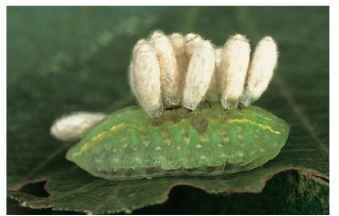Cockroach
Cocoon
A cocoon is commonly believed to be the silken protective covering within which the caterpillars of many moths and a few butterflies pupate. Other orders of insects also spin silk and form cocoons, including Siphonaptera (fleas), Hymenoptera (ants, bees, and wasps), Neuroptera (lacewings and antlions), and Trichoptera (caddisflies).
Lepidoptera cocoons can be very thick and tough, such as that of the silkworm, Bombyx mori, or they can be limited to a relatively few strands of silk that keep the pupa from falling or that hold materials together to form a shelter. Cocoons such as those of the silkworm are composed of a single continuous strand of silk that is unwound in commercial silk production. Other lepidopteran cocoons may also be composed of a single strand, but the strand is usually intertwined in a way that is very difficult to unwind.
There are many kinds of lepidopteran cocoons. Some are formed from substrate materials held together by silk, others are so tough and juglike that they have a special escape lid woven at the end for the emergence of the adult (slug caterpillars, Limacodidae). Some lepidopterans such as the cecropia moth, Hyalophora cecropia (Saturniidae), spin an elongate cocoon with a one-way escape hatch at the end. The tent caterpillars, Malacosoma (Lasiocampidae), spin a complete cocoon that is infused with a yellow or whitish powder that can be irritating to predators. Emergence is accomplished by secretion of a fluid that softens and dissolves part of the cocoon. Many woolly bear caterpillars (Arctiidae) incorporate the caterpillar’s spiny setae (which can also be irritating) into the cocoon.
Emergence from a pupa in the soil is usually by the adult crawling upward and often occurs after a rain softens the soil. Other adults emerge by cutting or forcing their way through the wall of the cocoon with sharp structures on the pupal head that are moved by the adult inside the pupal skin. Generally, if the pupa is capable of forward movement, it only partially protrudes from the cocoon, because it is held in place by forward-projecting spines near its rear that anchor it within the cocoon, enabling the adult to pull out of the pupal skin more easily.
Caterpillars that live in bags or cases attach the bag firmly with silk to the host (or some other substrate) and pupate within these structures. Winged male bagworms (Psychidae) emerge from the bag, but the females of most species are wingless and remain inside the bag where they are fertilized by the males’ insertion of their long abdomens into the open end of the bag. Females usually lay their eggs inside the bag and die.
Hymenopteran cocoons are highly variable in appearance, ranging from the tightly spun cocoons of some parasitic ichneumonid wasps that are suspended on a long silken thread to the more loosely spun cocoons of some braconid wasps such as those found clustered on the outside of caterpillars (Fig. 1). Ants also spin cocoons. When ant nests are opened, many ants rush off carrying larvae and cocoons (the larger, smoother objects that look like short hotdog buns and are thought to be eggs by some). Sawfly larvae spin cocoons that are similar to ant cocoons, and most bee and wasp larvae spin cocoons inside the cells provided by the adults.

FIGURE 1 Multiple parasitic wasp cocoons (Braconidae) formed by larvae after emerging from the slug caterpillar, Lithacodes fasci-ola. (Photograph by David J. Wagner, University of Connecticut.)
Flea (Siphonaptera) larvae spin cocoons covered with debris in areas where the larvae have been feeding. Lacewing larvae (Neuroptera: Chrysopidae) spin tight, egg-shaped cocoons in some snug spot near where they have been feeding. Caddisfly larvae (Trichoptera) are aquatic; many use their cases made of silk or materials spun together with silk as cocoons by attaching them to the substrate and sealing off the ends.
